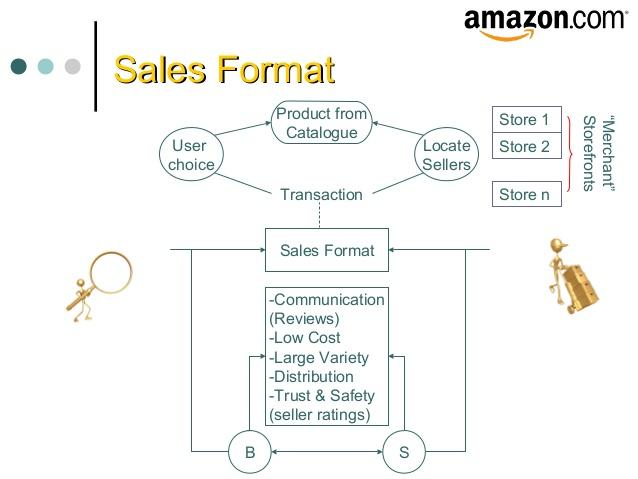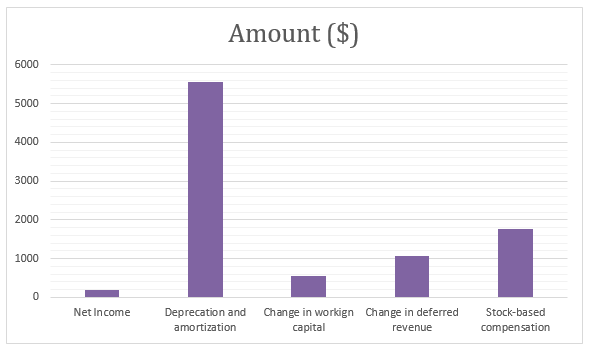Introduction
Structure: The Realm of Virtual Reality
Over 20 years in online retail, Amazon has become a household name for the place where one can purchase a variety of products and services with only a few clicks. From the perspective of the sales-related processes, Amazon’s structure is rather simple. As Figure 1 below shows, the company uses a five-element framework that helps get the end product to the target customer in a manner as efficient and expeditious as possible.

E-Commerce as the Primary Tool
Providing services related to purchasing products on the Internet, Amazon operates only in the online environment. Because of the nature of its services and the environment, in which the firm operates, it does not need to be represented by a retail store. Consequently, e-commerce should be viewed as the primary sales channel of Amazon.
Omnichannel Companies as Threats
However, the lack of presence in the traditional retail area poses a threat to the company’s well-being and competitiveness rates. Seeing that most of its rivals are represented in the retail department, Amazon may lose some of its audience to the above competitors. The framework, in which the latter operates, and which is known under the title of multichannel fulfillment (Panigrahi, 2013), implies the incorporation of retail shops into the sales channel along with the popular e-channels (Rowell, 2013).
The omnichannel model supported by a range of organizations is a serious threat to Amazon’s success in the target market. The ship-from-store strategy that Amazon resorted to in response, therefore, is a sensible step. Combined with e-commerce, the strategy permits the design of the omnichannel fulfillment strategy that will help address the emergent competition-related issues.
Multichannel Fulfillment
In light of the above issues, Amazon has recently decided to design the so-called multichannel fulfillment. Although the framework under analysis was designed for the company’s customers and suppliers as opposed to the needs of the organization, it still should be viewed as a giant step in the right direction: “Multi-Channel Fulfillment is Amazon’s service to enable you to fulfill orders from sales channels other than Amazon.com (such as your company website) using the inventory that you have stored in the Amazon fulfillment center” (Amazon, 2016, par. 1).
Members: The Participants That Matter
Retailers for Amazon Devices: A Breath of Fresh Air
Despite doubtlessly owning the monopoly over the e-sales department, Amazon has been attempting to introduce several retail services as well. While some might consider the given decision as a retreat and a means to escape being devoured by smaller businesses, it, in fact, is a reasonable strategy. Amazon has lately entered the retail arena to sell its devices (primarily, Kindles).
Wholesalers: from AmazonSupply to Amazon Business
At some point in the firm’s development, the leaders of Amazon decided that the company needed to be represented at the wholesale level as well. The decision of the leaders is understandable in light of the tough competition in the target market and the fact that most rivals were represented in wholesale. Thus, AmazonSupply was born.
However, as the company evolved, the idea was abandoned. In lieu of AmazonSupply, the Amazon Business emerged. The new and improved retail-related service is supposed to offer products both directly from Amazon as well as from third parties (Demery, 2016).
Industrial Distributors: What AmazonSupply Really Meant
Although AmazonSuppy is no longer in existence, it has left its mark in the history of Amazon as one of its industrial distributors.
Allocation of Channels and Flows
Channels: E-Commerce as the Foundation
Because of the specifics of its services and the target audience, whose needs it has to meet, Amazon has been using e-commerce-related sales channels for a while.
Flows: Free Cash Flow (FCF) as the Key Tool
One must admit that the tool chosen by the organization proved to be rather efficient in the environment of the global economy. The specified approach helps coordinate the financial transactions in a more accurate manner. However, as Figure 2 below displays, the company could use improvements in its cash flow model as most of the expenditures of the company were unrelated to sustaining the business.

Meeting Customers’ Demand for Service Outputs
Segmentation
To make sure that the customers’ needs are met and that their demands are taken into account and addressed properly, Amazon has been using segmentation as the foundational strategy. A closer look at the current approach toward segmentation in the Amazon Company will show that the managers have created a rather impressive segmentation strategy based on targeting every single customer individually (Banker, 2013).
Broad Titles Variety
It could be argued that the provision of more options for titles variety could help meet the needs of individual customers.
Suggestions for Improvement of the SalesForce
Customer Service
Despite being targeted at meeting the needs of an individual buyer, Amazon still needs significant improvements as far as its customer services are concerned. For instance, customer support service clearly needs a redesign as a number of customers have been complaining about having little to no feedback from the company and its representatives after their query. Similarly, customer satisfaction rates could be increased by addressing the issues regarding the quality and the speed of product deliveries.
Return Policy
At first glance, the current return policy of the Amazon Company is rather bearable. According to the information provided by the customer support team, the eligible for a full refund after returning their purchases within 20 days from the moment of acquiring them provided that the product remains new and unopened. The policy, however, has several evident dents in it, the term “unopened” being the key one. In most cases, it is only after unwrapping the package that a buyer sees its flaws. Therefore, the current policy could be shaped so that buyers could receive a full refund for returning defective products even if the cover has been taken off.
Personalized Recommendations
The company is evidently geared toward meeting the needs of individuals rather than creating mass products. Amazon manages to cater to the needs of every single customer, which is beyond impressive. It is essential, therefore, that the firm should retain its strategy when altering its sales channels.
Prime vs. No-prime
The idea of encouraging customer loyalty by providing special opportunities and making unique offers to prime customers is a sensible decision. However, Amazon must also make sure that the needs of nonprime customers are also met.
Ratings and Reviews
The significance of customer ratings and reviews is not to be underrated, either. As one of the most efficient and by far the fastest tools for retrieving feedback from the target population, online surveys must be incorporated into the company’s framework. However, the surveys must not be obtrusive; otherwise, the customers are likely to get frustrated very soon. The adoption of the Likert-type scale as the basis for surveys should be considered since it allows locating customer satisfaction rates with rather high precision.
Reference List
Amazon. (2016). Multi-channel fulfillment. Web.
Banker, S. (2013). Amazon vs. Walmart: E-commerce vs. omni-channel logistics. Forbes. Web.
Demery, P. (2016). Say hello to Amazon Business, good-bye to AmazonSupply. Web.
Don’t be fooled by Amazon’s cash flow. (2016). Web.
EBay vs. Amazon. (2015). Web.
Panigrahi, K. S. (2013). Seamless purchase – an insight into the issues. Bhubaneswar: Saraswat Institute of Management. Web.
Rowell, J. (2013). Omni-channel retailing. Web.